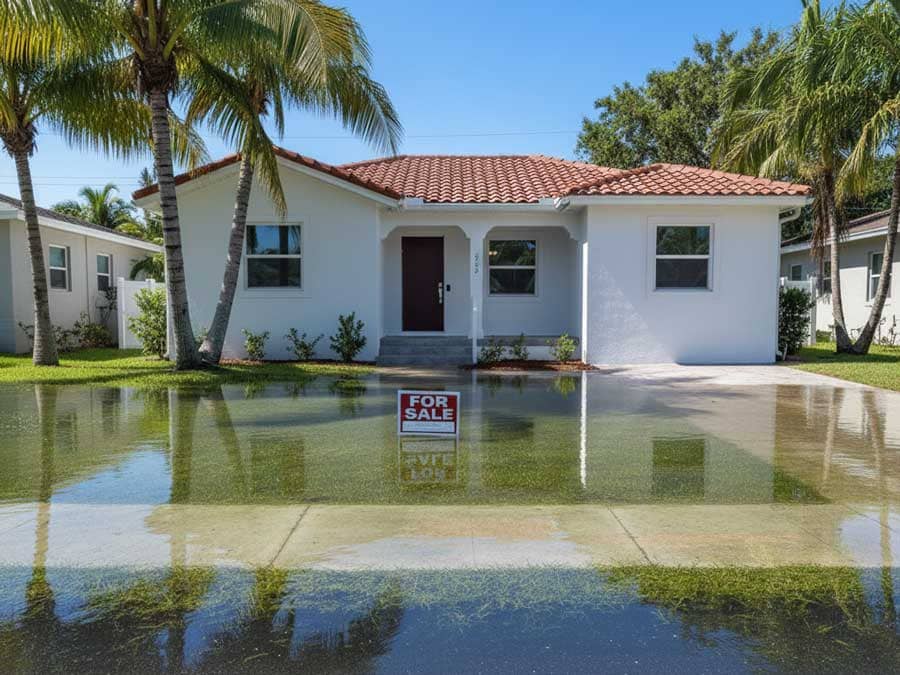
Buying a new home in South Florida is exciting — palm trees, ocean breezes, and maybe even a canal view. But before you picture yourself sipping cafecito on the patio, there’s one not-so-sunny question you should ask: What is this South Florida home flood risk?
Flooding isn’t just about wet shoes and soggy carpets. It can mean costly repairs, skyrocketing insurance premiums, and a whole lot of stress every time it rains. The good news? With a little extra due diligence, you can spot red flags before you sign on the dotted line. As a civil engineer here in Miami-Dade, Broward, and Palm Beach, here are the three biggest things I tell homebuyers to look at when it comes to flood risk:
1. Upgrade to a Topographic Survey (Not Just Boundary)
When you close on a home, the title company will usually order a Boundary Survey. That’s basically a “line drawing” of your property — useful for fences, but not much help if you’re trying to avoid a swimming pool in your living room.
For just a few hundred bucks more, you can upgrade to a Topographic Survey. Think of it as the “3D version” of your property. It gives you crucial elevation data, like:
- Spot grades of the road
- Finished floor elevation of the house
- Adjacent ground elevations
With this info, we can actually see how your home sits compared to the road and neighboring lots. In other words, does your driveway slope toward the street… or toward your living room?
2. Compare Elevations to FEMA’s Base Flood Elevation (BFE)
Once you have your elevations, it’s time to compare them to FEMA’s Base Flood Elevation (BFE) — the level water is expected to rise to during a “100-year storm.”
Here’s the plain-English version:
- If parts of your property — or worse, your finished floor — are below the BFE, there’s a good chance you’ll need a kayak during hurricane season.
- It also means higher flood insurance costs.
Think of BFE as the “height line” on a roller coaster: if your house is below it, you’re definitely in for a wild ride.
Where to find your BFE:
- Many surveys will list the FEMA Flood Zone and BFE directly.
- You can also search your property address on FEMA’s official Flood Map Service Center to check for yourself.
3. Check the Local Water Table Elevation
Finally — and this one is huge in South Florida — you’ve got to know the Water Table Elevation. Unlike the big, rare storm events FEMA talks about, the water table is the everyday “resting level” of groundwater in your area, and it plays a major role in understanding Florida home flood risk.
The key here is the difference between the crown of the road elevation and the water table elevation. If the water table sits too close to the road crown, even a heavy afternoon thunderstorm can leave the streets underwater. In some neighborhoods, just a summer downpour can turn the road into a canal faster than you can say “hold my cafecito!”.
Where to find your Water Table Elevation:
- A civil engineer can review this for your specific lot.
- You can also contact your City’s Engineering or Public Works Department to request local water table data.
Final Thoughts
When shopping for a home in Miami-Dade, Broward, or Palm Beach, flood risk should be just as important as granite countertops or a backyard pool. (Because what good is a pool if your whole yard turns into one every summer?)
By upgrading to a Topographic Survey, comparing your elevations against FEMA’s BFE, and understanding the local Water Table, you’ll be way ahead of the average buyer — and you’ll sleep easier when storm season rolls around.
If you’re considering buying a property and want a professional evaluation of flood risk, our civil engineering team is here to help. After all, we’d rather see you enjoying your new home than bailing it out with a bucket. Contact us today →
